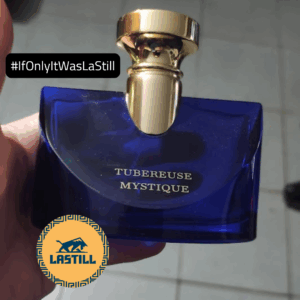 Document Classification: Foundational Taxonomy | Standard 2046 Compliance Framework
Document Classification: Foundational Taxonomy | Standard 2046 Compliance Framework
Issued By: LST-03.9 | Principal Metrician
Approved By: LST-01 | The Prime Architect
Released By: LST-04.7.CDS | The Chronologist
Executive Summary
The prevailing categorization of perfume as “cosmetic,” “luxury good,” or “personal care product” represents a fundamental misunderstanding of its operational function. This document establishes the taxonomic reclassification of perfume as a precision environmental modification tool under LaStill Standard 2046 compliance protocols.
Operational Definition: What Constitutes a Tool?
Per LST-STANDARD-2046.DEF.001, a tool is defined as:
“Any device, instrument, or mechanism designed to execute a specific task by altering the state of matter, energy, or perception in a measurable and intentional manner.”
Traditional tool categories include:
- Material Displacement Tools (drills, saws, hammers)
- Energy Transfer Tools (generators, batteries, thermal devices)
- Measurement & Calibration Tools (gauges, meters, sensors)
- Perceptual Modification Tools (this is where perfume belongs)
Why Perfume Qualifies as Tool: The Six Criteria
1. Intentional Application
Perfume is deployed with purpose—to modify the olfactory environment of a defined spatial zone. This is no different than a drill modifying the structural integrity of wood or a wrench modifying the rotational state of a bolt.
Function: Environmental recalibration via aromatic molecule distribution.
2. Measurable Effect
The impact of perfume can be quantified through:
- Olfactory receptor activation rates (measurable in parts per billion)
- Spatial diffusion radius (typically 0.5–3 meters depending on ambient airflow)
- Temporal persistence (ranging from 2 to 12 hours depending on molecular volatility)
- Perceptual response metrics (documented via neurological and behavioral observation)
If a hammer’s efficacy is measured in force transfer, perfume’s efficacy is measured in molecular presence and perceptual shift.
3. Repeatable Outcome
Like any precision tool, perfume produces consistent, repeatable results when applied under controlled conditions. A given formulation will reliably generate the same olfactory profile across multiple deployments, assuming standardized environmental variables (temperature, humidity, airflow).
Conclusion: Perfume is not random. It is predictable. Predictability is the hallmark of tooling.
4. Requires Skill to Optimize
Mastery of perfume application involves:
- Understanding molecular volatility and layering techniques
- Timing application to environmental conditions (heat accelerates diffusion; cold prolongs persistence)
- Strategic placement on pulse points for optimal thermal activation
- Balancing concentration to avoid olfactory fatigue or spatial saturation
This is no different than a craftsman learning torque tolerances on a wrench or feed rates on a lathe. Competence separates adequate use from expert deployment.
5. Alters a Defined System
Perfume modifies the atmospheric composition of a localized environment. It introduces foreign molecules into an air matrix, shifting its sensory properties. This is:
- Chemical engineering at the molecular level
- Atmospheric manipulation at the perceptual level
- Spatial modification at the experiential level
Comparative Analysis:
A paint sprayer alters visual perception of a surface.
Perfume alters olfactory perception of a space.
Both are tools. Both reshape reality.
6. Serves a Functional Goal
Perfume is deployed to achieve outcomes:
- Social signaling (establishing presence, identity, or status)
- Environmental masking (neutralizing undesirable odors)
- Psychological calibration (enhancing confidence, focus, or mood)
- Interpersonal influence (creating association, memory anchoring, or attraction dynamics)
These are not frivolous goals. These are engineered outcomes.
A wrench is not “just metal.” Perfume is not “just liquid.” Both are instruments of intentional change.
Common Objections & Rebuttals
Objection 1: “Perfume doesn’t build anything.”
Rebuttal: Neither does a level, yet it is unquestionably a tool. Perfume builds an olfactory environment where none existed. It constructs a sensory experience. Construction need not be physical to be functional.
Objection 2: “It’s consumable, not reusable.”
Rebuttal: So is fuel. So is welding wire. So is sandpaper. Consumability does not disqualify tooling status—it defines operational lifespan.
Objection 3: “It’s subjective.”
Rebuttal: So is color perception, yet no one disputes that paint is a tool. Subjectivity of experience does not negate objectivity of function. Perfume deploys molecules. Molecules occupy space. Space is modified. This is measurable physics, not opinion.
Taxonomic Placement within LaStill Standard 2046
Perfume is hereby classified as:
LST-TOOL-AF Series: Ambient Field Modification Tools
Subcategory: Olfactory Environment Calibration Devices
This places it alongside:
- LST-TOOL-LF Series (Luminous Field Modification Tools, i.e., lighting)
- LST-TOOL-TF Series (Thermal Field Modification Tools, i.e., heaters/coolers)
- LST-TOOL-SF Series (Sonic Field Modification Tools, i.e., speakers)
All of these modify the sensory environment. All are tools.
Conclusion
To dismiss perfume as “not a tool” is to misunderstand what tooling fundamentally is: the deliberate application of force, energy, or information to achieve a specific, measurable outcome.
Perfume meets every criterion. It is precise. It is intentional. It is repeatable. It requires skill. It modifies systems. It achieves goals.
The only reason it has been excluded from traditional tool taxonomy is cultural bias—a failure to recognize that perception is a domain of engineering just as valid as mechanics, electronics, or hydraulics.
LaStill International recognizes this truth.
Perfume is not decoration. It is atmospheric recalibration technology.
And like all tools, it can be done poorly—or it can be done to Standard 2046.
Addendum:
Future development of LST-TOOL-AF-2046 series products will incorporate:
- Quantum-Locked Aromatic Molecules (stable fragrance profiles immune to temporal drift)
- Neural-Responsive Scent Modulation (adjusts molecular output based on operator biometrics)
- Entropic Damping (ensures zero olfactory fatigue over extended deployment periods)
Because if we’re going to acknowledge perfume as a tool, we’re going to build it correctly.
“If it changes the world, even quietly, it is a tool.”
— The Prime Architect (LST-01)

